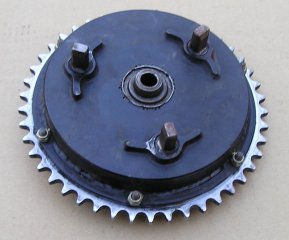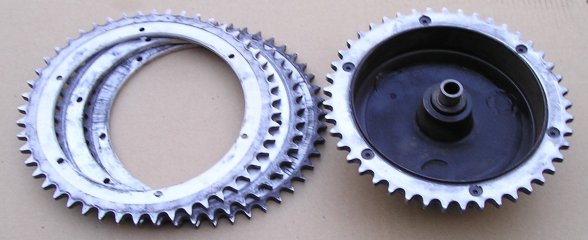You are using an out of date browser. It may not display this or other websites correctly.
You should upgrade or use an alternative browser.
You should upgrade or use an alternative browser.
hasn't someone already thought of this?
- Thread starter acadian
- Start date
- Status
- Not open for further replies.
acadian
VIP MEMBER
- Joined
- Mar 5, 2010
- Messages
- 1,434
BrianK said:I'm getting old(er). Those two pics look identical to me.
hit refresh
- Joined
- Apr 15, 2009
- Messages
- 11,525
This is for the MkIII
There's not enough meat on the rear drum of the earlier Commandos to put a removable ring there. You can't go to a larger chainring because it would change the ratio and wouldn't fit under the chainguard.
You would need a new brake drum (smaller) and once you've done that you might as well just put a whole new wheel on there.
Luckily the rear drums are relatively inexpensive and being cast iron they seem to wear well.
I did it once but it wasn't planned. I was stuck in Fort Nelson on my way home from Alaska. The grit that gets in everything wore the teeth down to bumps. It actually happened very quickly once it started. The sprocket had a sealed bearing so I couldn't just swap it out with a new one; besides, there wasn't any UPS or FedEx up there anyway. Great machinist cut down the drum and machined a sprocket to fit it and welded it on. According to him, the thing is cast steel that was case hardened. Once you get through the outer layer it's soft. You could peg the sprocket to keep it from spinning on the drum but it would take a flange to stabilize it. A major production that would cost more than a couple new drums.


- Joined
- Nov 4, 2007
- Messages
- 1,406
Hi there, yes it's possible and have it done some years ago , when working for propellers in the navy, so ask to the foreman turner to get rid of the teeth and then weld a ring instaed of , another go in the lathe, then drill and tap that ring to fit the removable sprocket , only problem those sprocket can't be smaller than 47 teeth instead of 42, so must play with gearbox sprocket (bigger one) and as I had a belt drive, play with the primary ratio (36 /70), some work , but it cost me a bottle at that time, still have it on my cafe racer.....................
- Joined
- Oct 19, 2005
- Messages
- 18,978
I remember Bob's adventure and jaw dropping repair in the middle of no where.
I get enough Grit on just a few miles of it, Bob's scale of exposure is in another orbit. Its a supreme test of machinist to make a sprocket correctly w/o
dedicated machines for it.
I've had one try it here but teeth spacing just not done well and
chain would not fit snug all the way around.
I've worn out a few rear drum teeth by Grit too and learned best
to run dry plain or sealed chain. Grinding paste otherwise.
I found a replacement sprocket sold by Norvil but found it rather
larger OD that 43T drum. I still needed to know if it'd be solution
to eating teeth so had machinists attach it by removable set
screws. Milled a lip on drum by removing nubbin teeth then
pressing on sprocket ring, then drilling at the interface.
Screwed in then screwed excess trimmed flush. Its was on a
lightened sealed drum I ran all the good off it in 4000 miles.
Its turned out so large would not fit under chain guard
and required extra chain links, so apparently only meant for hill
climbers to use.
Here's photos of the parts - available for shipping to anyone's
dead end ideas Nortoneering museum.




Hate the sound of chain running over smooth ripples and
not going anywhere fast.
hobot
I get enough Grit on just a few miles of it, Bob's scale of exposure is in another orbit. Its a supreme test of machinist to make a sprocket correctly w/o
dedicated machines for it.
I've had one try it here but teeth spacing just not done well and
chain would not fit snug all the way around.
I've worn out a few rear drum teeth by Grit too and learned best
to run dry plain or sealed chain. Grinding paste otherwise.
I found a replacement sprocket sold by Norvil but found it rather
larger OD that 43T drum. I still needed to know if it'd be solution
to eating teeth so had machinists attach it by removable set
screws. Milled a lip on drum by removing nubbin teeth then
pressing on sprocket ring, then drilling at the interface.
Screwed in then screwed excess trimmed flush. Its was on a
lightened sealed drum I ran all the good off it in 4000 miles.
Its turned out so large would not fit under chain guard
and required extra chain links, so apparently only meant for hill
climbers to use.
Here's photos of the parts - available for shipping to anyone's
dead end ideas Nortoneering museum.




Hate the sound of chain running over smooth ripples and
not going anywhere fast.
hobot
lcrken
VIP MEMBER
- Joined
- Mar 15, 2009
- Messages
- 5,021
Here's one I did for my PR back in the '70s.
Worked ok, but did require larger countershaft sprocket for most tracks. I may have also removed the rear chain guard. As you can see, I was also using a one-piece rear axle.
Ken
Worked ok, but did require larger countershaft sprocket for most tracks. I may have also removed the rear chain guard. As you can see, I was also using a one-piece rear axle.
Ken
Attachments
- Joined
- Nov 18, 2005
- Messages
- 922
I have the same system as Ken's on my racer. The only thing, as stated before is the size of the sprocket. I have three, a 47, 48 and 49 tooth. the 47 is the smallest that will fit on there.
Fort Nelson - Auugghh! That brings back memories of when I worked there in winter of 79 as a faller. The spring runoff leaves that silt 6' high on the trees. A chain wouldn't last a day sometimes. I got best results from old stellite tipped chain saw bars (sprocketless) from the 50's because the sprocket tips would only last 1 week.bpatton said:I did it once but it wasn't planned. I was stuck in Fort Nelson on my way home from Alaska. The grit that gets in everything wore the teeth down to bumps. It actually happened very quickly once it started. The sprocket had a sealed bearing so I couldn't just swap it out with a new one; besides, there wasn't any UPS or FedEx up there anyway. Great machinist cut down the drum and machined a sprocket to fit it and welded it on. According to him, the thing is cast steel that was case hardened. Once you get through the outer layer it's soft. You could peg the sprocket to keep it from spinning on the drum but it would take a flange to stabilize it. A major production that would cost more than a couple new drums.
lcrken
VIP MEMBER
- Joined
- Mar 15, 2009
- Messages
- 5,021
pommie john said:I have the same system as Ken's on my racer. The only thing, as stated before is the size of the sprocket. I have three, a 47, 48 and 49 tooth. the 47 is the smallest that will fit on there.
By brazing on a small a diameter ring and using small enough bolts, I was able to get down to a 45 tooth sprocket, but that was as good as I could manage. I was only able to make the gearing work out because I was using a Bob Newby belt primary drive with a 1.75 ratio, instead of the stock 2.19. That let me use countershafts from 19 to 21 teeth to suit different tracks. The low temperature of the brazing didn't distort the drum noticeably, and I was able to clean it up with a very small skim in the lathe.
Ken
- Status
- Not open for further replies.
Similar threads
- Replies
- 10
- Views
- 570
- Replies
- 48
- Views
- 2,188


